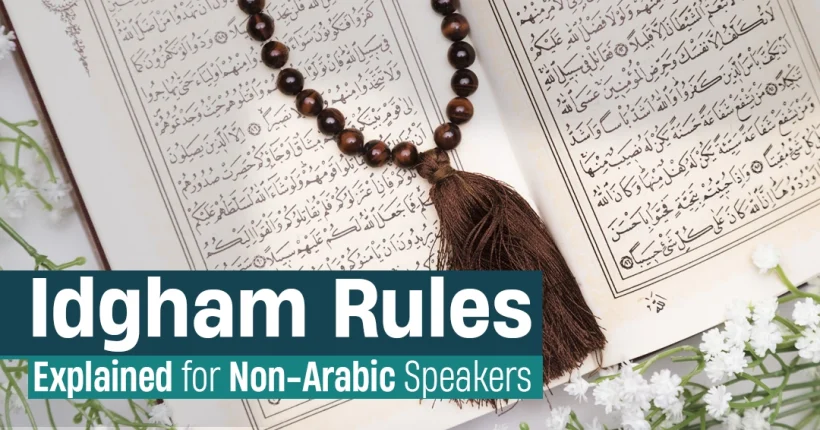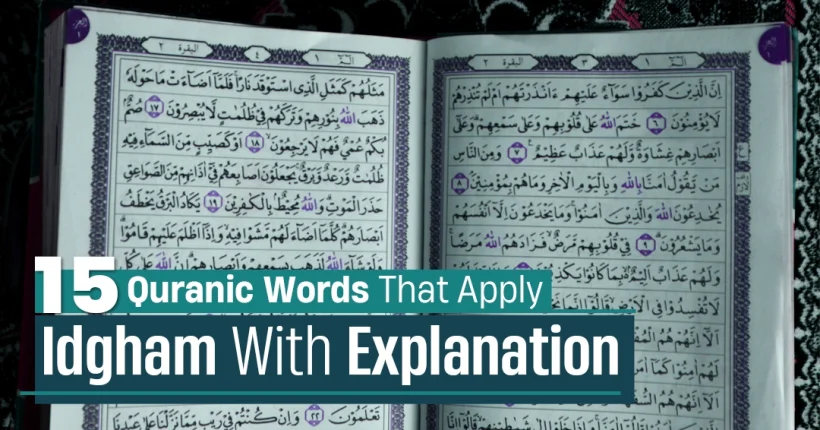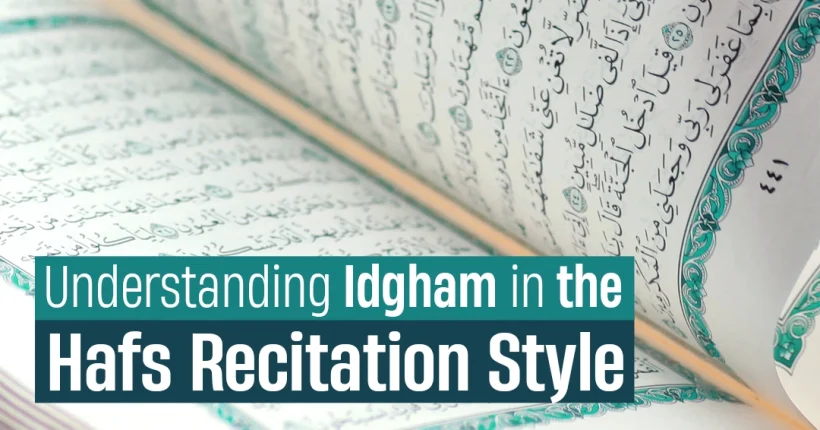The types of Idgham in Tajweed are crucial rules that empower Quran learners to recite properly and smoothly. By discovering where and when exactly to merge given letters, you can transform your recitation to be more flowy, polished, and obedient to how the Quran descended.
In this guide, we’ll discuss the types of Idgham in Tajweed through brief examples with useful tips that will aid you in learning them easily.
What Is Idgham in Tajweed?
Upon studying the types of Idgham in Tajweed, the first thing to know is what is ‘Idgham’. In Tajweed, the term ‘Idgham’ is used when one letter merges into another at pronunciation, rather than pronouncing the first one clearly.
Mostly, this happens when a Noon Sakinah (نْ) or Tanween (ً ٍ ٌ) occurs before some specified letters in Arabic script. By understanding Idgham, students can recite the Quran fluently and melodiously, exactly as it was revealed.
Importance of Understanding Idgham
Idgham rules help you recite with proficiency, precision, and the natural rhythm intended in the Quranic revelation. The inability to make proper use of Idgham leads to incorrect recitation, affecting the meaning and religious impact of the verses.
Enhancing Fluency and Pronunciation
All of the types of Idgham in Tajweed contribute to the smooth and beautiful recitation of the Quran. Mixing sounds with some levels of Idgham—especially with or without ghunnah (nasalization)—increases the degree of rhythm and voice clarity of your recitation.
Not only will this make recitation sound clear, but also it will help with more control over articulation as well as your breathing.
Knowing the types of Idgham in Tajweed provides a solid basis to proceed and move to more advanced Tajweed rules. If you understand how sounds are joined and when to apply each rule, the rest of the rules of Tajweed are simpler to comprehend.
Idgham trains your tongue and ear to detect subtle differences in pronunciation, setting the stage for mastery of recitation.
The 6 Types of Idgham in Tajweed
Mastering types of Idgham in Tajweed allows the students to connect letters smoothly together and recite Quranic verses with grace and precision. Each type is governed by its rules and examples. Knowing where and how to use them helps with smooth and correct recitation.
Let us thoroughly discuss each of them with simple explanations and examples.
1. Idgham with Ghunnah (إدغام بغنة)
This is most common among the types of Idgham in Tajweed, including a sound of nasal type known as ghunnah. It occurs whenever Noon Sakinah (نْ) or Tanween occurs before any of the letters ي، ن، م، و (Ya, Noon, Meem, Waw).
Rule: Make the sound and nasal vibration together for two counts.
Example:
مِن وَالِدِهِ is changed to مِوَّالِدِهِ
The Noon is here merged into Waw with a nasal sound.
2. Idgham without Ghunnah (إدغام بلا غنة)
In this type of the types of Idgham in Tajweed, there is fusion without any nasal sound. It is applied when Noon Sakinah or Tanween is preceded by ل، ر (Lam or Ra).
Rule: Merge smoothly without ghunnah.
Example:
مِن رَبِّهِمْ is pronounced مِرَّبِّهِم
This kind of Idgham requires a smooth transition without a nasal tone.
3. Idgham Mutamathilayn (Identical Letters Merge)
This is the type where two similar letters meet, one silent (sakin) and the other preceded by a vowel.
Rule: Join the first letter whole into the second.
Example:
ادْخُلُوا الْبَابَThe two د sounds are merged for better pronunciation.
4. Idgham Mutajanisayn (Similar Letters Merge)
This is one of the types of Idgham in Tajweed that is applied when two letters of the same articulation point (makhraj) but different qualities occur, one sakin.
Example:
يَذْبَحُونَ,
The ذ becomes part of the ب because they are close in articulation. This type of Idgham adds smoothness between similar-sounding letters.
5. Idgham Mutaqaribayn (Letters of Similar Articulation Points Merge)
This occurs when two letters have close articulation points and similar qualities, and one is sakin.
Example:
ارْكَبْ مَعَنَا
In this, the ب and م come close together, so they are smoothly blended. One of the types of Idgham in Tajweed, this one is subtle but critical for advanced students.
6. Complete and Incomplete Idgham
Complete Idgham (Kamil): The initial letter disappears completely.
Incomplete Idgham (Naqis): The initial letter is partly maintained (with ghunnah).
- Example of Complete: مِن رَبِّهِمْ – the Noon disappears.
- Example of Incomplete: مِن مَّالٍ – the Noon merges but with a clear nasal sound.
Being aware of the difference helps learners avoid common recitation errors.
Tips to Master the Types of Idgham in Tajweed
Understanding the types of Idgham in Tajweed may appear daunting at first, but once you grasp the methods and practice regularly, it becomes a natural part of your Quran recitation.
Whether you’re beginning from scratch or refining your Tajweed, these tips will help you understand and apply Idgham easily and accurately.
1. Learn the Letters of Each Of The Types of Idgham In Tajweed
Start by memorizing which letters create Idgham with Ghunnah, those without Ghunnah, and others like Mutamathilayn and Mutaqaribayn. Utilize flashcards or visual charts to help reinforce the relationship between each letter and its corresponding Idgham rule.
Having an awareness of the types of Idgham in Tajweed allows you to be able to use the rules immediately when you are reciting the Quran.
2. Practice with Short Surahs First
Surahs like Al-Fajr, An-Naba’, or Al-Mutaffifin contain several examples of Idgham. Reciting them slowly and repeatedly allows you to recognize where Idgham needs to be. After a while, you will start observing the types of Idgham in Tajweed naturally in longer Surahs as well.
3. Use Color-Coded Mushaf or Tajweed Apps
A color-coded Mushaf with Tajweed rules can point out where different types of Idgham in Tajweed occur visually.
Mobile applications that have Tajweed with audio examples are also useful, especially for auditory learners who want to hear the difference of each type with their ears.
4. Record and Listen to Your Recitation
During practice, record your recitation and compare it with a Qari (reciter). This allows you to check whether you are joining letters properly or omitting the nasal sound in Idgham with Ghunnah. It’s an easy but effective means of enhancement.
5. Live Feedback from an Experienced Teacher
No tip can replace the value of a teacher who can correct your mistakes in real-time. Joining a structured program where you’re guided step-by-step through the types of Idgham in Tajweed ensures steady progress and builds lasting confidence in your recitation.
That is why students from all over the world like Tareequl Jannah Academy. Well-trained teachers not only explain the rules easily but also give you one-to-one practice, helping you apply each type of Idgham properly in real Quranic verses.
Conclusion
Understanding and mastering the types of Idgham in Tajweed is an essential part of accurate and beautiful Quran recitation. From the flowing transitions of Idgham with Ghunnah to the subtle precision of Idgham without Ghunnah, each rule plays a role in preserving the divine eloquence of the Quran.
As a learner, don’t worry if the rules feel overwhelming at first. With consistent practice, the right tools, and the guidance of qualified teachers, these Tajweed principles become second nature, elevating both your fluency and your spiritual connection to the words of Allah ﷻ.





